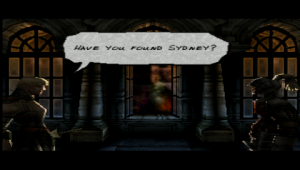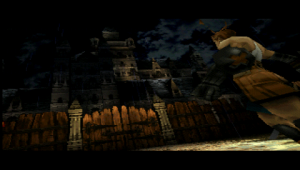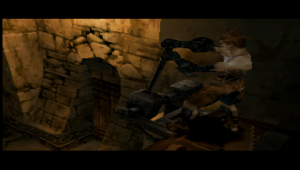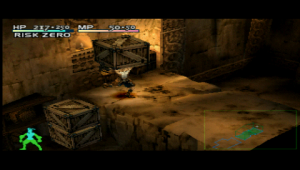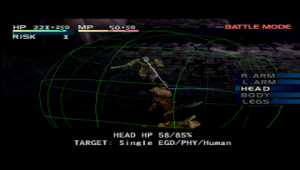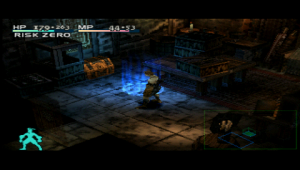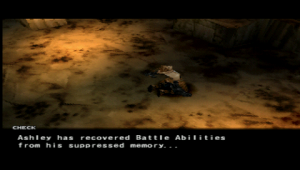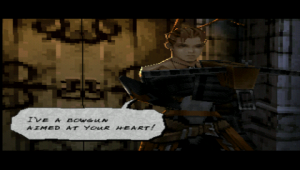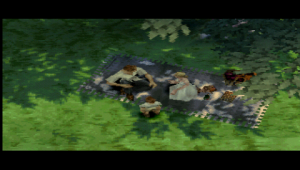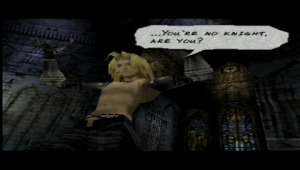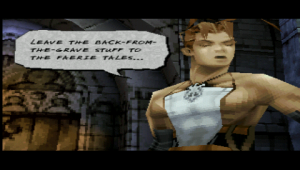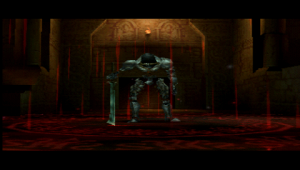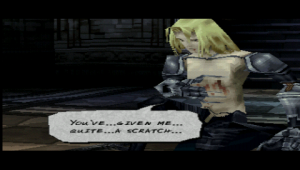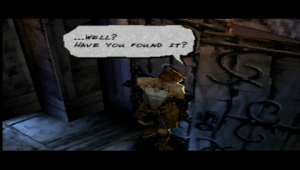After completing Tomba!, I had to pick another game to play on my PSP. The choice was between Vagrant Story and Jade Cocoon, and I even picked Jade Cocoon first, but that one ended up having a progress-breaking bug, so I had to abandon it after the first forest. Vagrant Story it is!
The Story of Vagrant Story
First of all, Vagrant Story takes place in the world of Ivalice, the one from Final Fantasy XII and the Tactics games. When the game was released, though, this wasn’t mentioned, so it would be more appropriate to say that the game was retconned into belonging to this universe.
The game takes place in the city of Lea Monde, on the continent of Valendia. A cult takes a duke and his family hostage and your job as Ashley Riot, a Riskbreaker of the Valendia Knights of the Peace (or VKP) is to take care of it. The story is out of your way throughout most of the game, but when there is storytelling, it’s usually very, very interesting. A plus is that, while it is a medieval setting, there’s a lot of modern elements and terms used, which works really well.
Game Mechanics
So why is this game a jewel? Vagrant Story was a game very ahead of its time. It’s extremely cinematic, the mechanics are unique, there are some advanced graphical effects and the approach to it all could even be called revolutionary. It’s flawed, though. Some of the elements could have been handled better and the mechanics are so complex, it turned away a lot of people.I actually own a physical copy of Vagrant Story, but I never completed it because it got too complicated for me.
Well, it’s been over a decade now, so I’m hoping I’m mentally more capable of doing it, because it really is an interesting game.
Vagrant Story is a one-person dungeon crawler, basically. Dungeons are split into rooms, with some doors being locked or blocked until you do something in some other room, miscellaneous block puzzles and switches scattered throughout the dungeon and, of course, treasures and enemies.
The battle is where it gets interesting. It looks and feels real time, though stats affect how often you can attack, what your hit and dodge chances are or how much damage you do and receive. When it’s your turn to attack, you press the circle button and, based on your weapon range, a sphere appears around your character. Any enemy within the sphere can be attacked. It gets more complex, though. Enemies have body parts, which you can target specifically. Some body parts are harder to hit, but take more damage, such as the head on humanoid enemies. Attacking the hands can cripple the enemy’s attack and attacking the feet can cripple their movement. There’s a lot of decision making to be had there, and also a lot of risk taking, so I guess that’s why Ashley is a Riskbreaker.
Weapons and Armor
It’s not all about the battle, though. A lot of it is about the gear to. Your weapons and armor have three set of stats.
There are the elemental affinities (fire, water, earth, air, light, dark). A weapon with a higher elemental affinity to fire will do more damage to water-based enemies and vice versa. An armor with an affinity to fire will take less damage from fire attacks. The six affinities are divided into opposites. Fire is opposite to water, air is opposite to earth and light is opposite to dark. Lastly, there’s the special, physical affinity. It has no opposite and it simply affects physical damage.
By dealing and receiving damage, you affect these affinities. Receiving fire damage increases your armor’s fire affinity. Dealing damage to water creatures increases your weapon’s fire affinity. However, this is where the opposites come into play. Whenever your weapon’s fire affinity increases, there’s a chance that the water affinity will drop and vice versa. Whatever the highest elemental affinity of the weapon is, that’s the type of damage that the weapon does.
There are also weapon and armor classes. Each enemy belongs to one of several classes. These are aranged circularly, like follows: evil – human – beast – undead – phantom – dragon – evil – human. What does that mean? It means that if, for instance, an undead enemy attacks Ashley, his armor’s undead class may rise, but his phantom class my drop. It goes further than that, so his dragon class might drop to, since it’s after phantom. I’m not really sure how far it goes, or what the odds are, but it definitely goes at least two steps ahead.
Finally, there are the weapon types. These fall into one of three – blunt, edged and piercing. They also affect damage, but I’m not completely sure on how yet.
Because of that, it’s important to carry around several weapons, to use correctly against various creatures. It’s a bit easier with armor and, since there’s a limit to the amount of stuff you can carry and a lot of armor slots for your character, I don’t think it’s really expected to carry around several armor sets.
Workshops
We’re still not done! Each item has two additional, variable stats. There are Damage Points and Phantom Points. Damage points reflect the amount of wear and tear a piece of equipment has. Using weapons or taking damage drops this value and when it reaches zero, the item effectiveness is halved. Phantom points, on the other hand, go up as you use items. When they reach the maximum, the effectiveness is doubled. The thing is, in order to repair the weapon or armor piece, you use phantom points to fill up damage points, so there’s a balance between those two.
Workshops? Yes, there are workshops in Vagrant Story and item repair is their least important function. Each weapon consists of a grip and a blade. You can disassemble and reassemble weapons, combining different grips with different blades, which affects some of the weapon’s stats. You can also combine blades, merging two different blades into a new one, which can change the weapon type completely, and merge their affinities, making the weapon stronger or weaker, depending on what you do. Finally, you can attach gems to weapons, provided there’s a gem slot on it. Gems also add to affinities and classes, which makes the whole thing even more complicated.
Each item is also made up from a specific material. These can be leather, wood, bronze, iron, hagane, silver and damascus. Not all workshops can handle all materials, which I guess is how the game balances equipment strength. The lower materials are a bit fuzzy on the matter, but there’s no doubt that damascus is by far the best one you can have and should strive for.
Abilities
We’re not done yet! Vagrant Story also has magic, divided into four classes – warlock, shaman, sorceror and enchanter. These are just schools of magic, made to help find spells easier. The spells can range from status changes (which are very useful in Vagrant Story) to recovery, damage and various other things.
There are also break arts, which are basically strong, weapon category specific (spear, sword, mace, etc.) skills which do a lot of damage, but also damage Ashley. You learn them as you use the appropriate weapons and they can be very useful in a fight.
Finally, there are chain and defense abilities. These can be bound to either Square, Circle or Triangle and are triggered manually by the player. Whenever you attack, an exclamation mark appears above Ashley’s head. Pushing one of the three bound buttons at the right moment triggers that chain ability. The same goes for defense abilities, except that you trigger them when Ashley gets attacked. You learn these abilities as you kill enemies and they are usually something like heal for 30% of damage done or do 40% of damage done, but it can be more interesting than that. It doesn’t have to be, though, because they are called chain abilities for a reason. You can chain them after each other, so your attacks can go on forever if you’re good enough.
However, as the battle goes along, Ashley’s Risk Points go up, and using chain abilities makes them go up even faster. When Risk Points are high, Ashley has a higher chance to do critical attacks, but he also takes far more damage and has a higher chance to completely miss an attack. For the most part, I feel that risk points should be kept low.
Leveling Up
There are no levels in the classical sense of JRPGs. After each boss kill, you get a slot machine where you can get a bonus stat increase, but other than that, you don’t gain levels. Instead, you increase your weapon and item stats, learn new break arts, chain and defense abilities and there are also a lot of stat-increasing items scattered throughout the game.
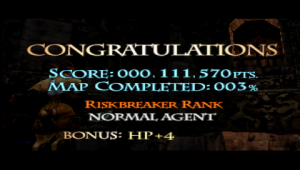
You get a score and a rank after beating a boss. I got lucky with the slot machine there. I think that’s the most you can get.
Sure, there’s no leveling up, but this is not a negative point for the game. You really won’t miss it.
The End
So basically, that’s it. Vagrant Story has an extremely complicated system which can be very interesting if you’re into that sort of stuff, but also game breaking if you’re not into it, which is why the game wasn’t a big success commercially. In addition to that, there are some poor design choices. For instance, there are shortcuts to set chain and defense abilities or use items and spells, but there are no shortcuts to switch weapons. For a game which is all about weapon switching, this is a major oversight. You basically end up spending 60-80% of your time in battle in menus, switching weapons.
Also, none of this is very well explained in the game. There’s a comprehensive manual, but it only covers the surface, without really explaining how it works exactly.
Game Progress
Let’s not forget what this blog is about – my game progression. I’ve been playing for a couple of hours now. I’m still at the catacombs, which is the first area, because I also managed to lose a few times. Vagrant Story is a bit clunky to play on the PSP, because of the lack of four shoulder buttons, which are all regularly used in the game. Because of that, I managed to get myself killed a few times, but not managing to heal in time.
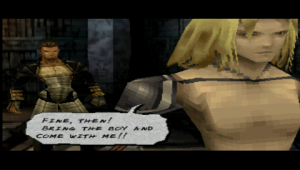
Sidney is the big baddie and Hardin is his number one. Note the cinematic camera angle. There’s a lot of those.
I can’t blame it all on the controls, though. Vagrant Story can be a difficult and challenging game and I can be careless, mostly due to not playing difficult and challenging games most of the time.
I’m still wrapping my head around the whole system, but for now, I’ve been equipping stronger armor as I was getting it and I’ve been using just two weapons. The first is a Scimitar named Fandango, which I’m using against living creatures (human, beast) and the second is a hatchet who’s name I forgot, which I’ve been using against undead and unliving things (undead, phantom, etc). I’ve fought one dragon and used the scimitar against it, but other than that, the monsters didn’t vary too much, so it was simple.
Recently, I found an awesome dagger called Soul Kiss, which has much higer stats against undead, so I switched to that from the hatchet. I also ran into my first workshop, so I ended up combining the dagger’s blade with a better hilt and renaming it to Death’s Bane. Finally, I disassembled Fandango, combined the blade with a glaive to turn it into another glaive and gave it a hilt with a jewel slot, so I could put a jewel I found into it. I named this new weapon Life’s Bane, to keep things simple and completely unimaginative. I haven’t been paying any attention to elemental affinities or weapon types (edged, piercing, blunt), so this will probably come back and byte me in the ass.
I’ve been using stat-increasing items as I was finding it. If that’s a mistake and there’s a way to make them more effective later on, I’ll have to just deal with it emotionally. As far as I can tell, Vagrant Story is meant to be replayed over and over again, so I might even do that at one point, or it might just be an empty promise, as it usually is with me and replaying games.
The slime enemies confuse me a bit. They are beasts, but they seem to be highly resistant to physical damage, so I’ve just been using spells against them. The bat enemies annoy me. They are fast and have a huge range, so they usually manage to hit me when I enter a room, but they die in one hit, so they just become annoying instead of being an actual threat. They’re basically the cliff racers of Vagrant Story.
I managed to beat three actual bosses – a dragon, an animated armor called Dullahan and a minotaur. All of them are quite common in Final Fantasy games, so I can see how the game can belong to the world, even if it is a retcon. I also beat several mid-boss encounters. I call them like that because they were tougher than regular encounters and the game made a big deal out of them with cut-scenes, but I didn’t get the slot machine after beating them, so they can’t be real bosses.
Sidney, the big baddie of Vagrant Story, is as androgynous as they get with Square games, but this time, he’s actually pretty cool, almost as cool as Sephiroth. I’m loving the way the story is told and how the characters are portrayed. I also love how the game was even graphically advanced. There are some really cool lighting effects in some of the scenes, and the comic-style dialog also looks great. I’ve actually seen animated hair on Callo, one of the NPCs to.
The intro to the game is told highly cinematically, with cool camera angles, pretty advanced actions scenes, great lighting and the credits cutting in during all of it, like they would in a movie. Of course, it’s still a PlayStation game, but in the context of the era, it was regarded as amazingly advanced.
The game doesn’t really start until after the first 30 minutes or so, though if you want, you can skip big parts of the story and the cut-scenes, which makes sense if you’re doing a replay. After each boss, depending on how well you did during the section, you get a score and a rank, which might also affect how lucky you get with the slot machine, but I’m not sure. Vagrant Story also tracks your map progress and time, so everything about it tells me the game revolves around being played several times.
Overall, the story has me hooked and the mechanics are nice and complicated, just the way I like them.
